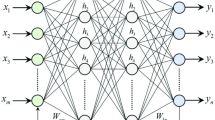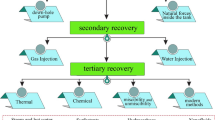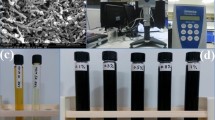Abstract
Given the excellent thermal properties of MXene, MXene nanomaterials-based nanofluids may have the potential of being used as heat transfer fluids. In this work, we have investigated the dynamic viscosity of MXene-palm oil nanofluid. To prepare the nanofluid, MXene (\(\hbox {Ti}_{{3}}\hbox {C}_{{2}}\)) nanoflakes were first synthesized by the wet chemistry method. Then, nanofluids with 0.01, 0.03, 0.05, 0.08, 0.1, and 0.2 mass% concentrations of MXene nanoflakes were prepared, and their dynamic viscosity values were determined for a wide temperature range of 18–100 \(^\circ \hbox {C}\). The dynamic viscosity of the developed nanofluid, for each concentration, was found to be a strong function of temperature and decreased with increasing temperature. The effect of MXene nanoflakes concentration on the dynamic viscosity was found to be more significant at lower temperatures than at higher temperatures. A multilayer perceptron artificial neural network model was also developed in the study. To develop the model, temperature and nanoflakes concentration were given as inputs to the ANN model, whereas dynamic viscosity was the output of the model. The optimum model was found through the trial and error method. Statistical parameters such as mean square error, mean average percentage error, and correlation coefficient (R) were used to evaluate the performance of the developed model. The values of these parameters, for the optimum ANN model, were found to be 4.733E−05, 0.507%, and 0.99975, respectively. 95.67% of the deviations were also found to be in range of ± 2%. The developed model showed good performance, and its predictions were in excellent agreement with the experimental data.












Similar content being viewed by others
References
Wen D, Lin G, Vafaei S, Zhang K. Review of nanofluids for heat transfer applications. Particuology. 2009;7(2):141–50.
Saidur R, Leong KY, Mohammad HA. A review on applications and challenges of nanofluids. Renew Sustain Energy Rev. 2011;15(3):1646–68.
Choi SUS. Enhancing thermal conductivity of fluids with nanoparticles. ASME (FED). 1995;231:99–105.
Nagarajan PK, Subramani J, Suyambazhahan S, Sathyamurthy R. Nanofluids for solar collector applications: a review. Energy Procedia. 2014;61:2416–34.
Tawfik MM. Experimental studies of nanofluid thermal conductivity enhancement and applications: a review. Renew Sustain Energy Rev. 2017;75:1239–53.
Sajid MU, Ali HM. Recent advances in application of nanofluids in heat transfer devices: a critical review. Renew Sustain Energy Rev. 2019;103:556–92.
Nazari MA, Ahmadi MH, Sadeghzadeh M, Shafii MB, Goodarzi M. A review on application of nanofluid in various types of heat pipes. J Central South Univ. 2019;26(5):1021–41.
Poplaski LM, Benn SP, Faghri A. Thermal performance of heat pipes using nanofluids. Int J Heat Mass Transf. 2017;107:358–71.
Sureshkumar R, Mohideen ST, Nethaji N. Heat transfer characteristics of nanofluids in heat pipes: a review. Renew Sustain Energy Rev. 2013;20:397–410.
Verma SK, Tiwari AK. Progress of nanofluid application in solar collectors: a review. Energy Convers Manag. 2015;100:324–46.
Xian HW, Sidik NAC, Najafi G. Recent state of nanofluid in automobile cooling systems. J Therm Anal Calorim. 2019;135:981–1008.
Seraj M, Yahya SM, Badruddin IA, Anqi AE, Asjad M, Khan ZA. Multi-response optimization of nanofluid-based IC engine cooling system using fuzzy PIV method. Processes. 2020;8(1):30.
Boungiorno J, Hu LW, Kim SJ, Hannink R, Truong B, Forrest E. Nanofluids for enhanced economics and safety of nuclear reactors: an evaluation of the potential features issues, and research gaps. Nucl Technol. 2008;162(1):80–91.
Dai W, Kheireddin B, Gao H, Liang H. Roles of nanoparticles in oil lubrication. Tribol Int. 2016;102:88–98.
Nair V, Tailor PR, Parekh AD. Nanorefrigerants: a comprehensive review on its past, present and future. Int J Refrig. 2016;67:290–307.
Ali F, Khan I, Sheikh NA, Gohar M, Tlili I. Effects of different shaped nanoparticles on the performance of engine-oil and kerosene-oil: a generalized brinkman-type fluid model with non-singular kernel. Sci Rep. 2018;8:15285.
Dehkordi BAF, Abdollahi A. Experimental investigation toward obtaining the effect of interfacial solid-liquid interaction and basefluid type on the thermal conductivity of CuO-loaded nanofluids. Int Commun Heat Mass Transf. 2018;97:151–62.
Sedeh RN, Abdollahi A, Karimipour A. Experimental investigation toward obtaining nanoparticles’ surficial interaction with basefluid components based on measuring thermal conductivity of nanofluids. Int Commun Heat Mass Transf. 2019;103:72–82.
Ju WX, Fang LX. Influence of pH on nanofluids’ viscosity and thermal conductivity. Chin Phys Lett. 2009;26(5):056601.
Asadi A, Alarifi IM, Ali V, Nguyen HM. An experimental investigation on the effects of ultrasonication time on stability and thermal conductivity of MWCNT-water nanofluid: finding the optimum ultrasonication time. Ultrason Sonochem. 2019;58:104639.
Xia G, Jiang H, Liu R, Zhai Y. Effects of surfactant on the stability and thermal conductivity of Al2O3/de-ionized water nanofluids. Int J Therm Sci. 2014;84:118–24.
Ahmadi MH, Mirlohi A, Nazari MA, Ghasempour R. A review of thermal conductivity of various nanofluids. J Mol Liquids. 2018;265:181–8.
Murshed SMS, Estelle P. A state of the art review on viscosity of nanofluids. Renew Sustain Energy Rev. 2017;76:1134–52.
Darvanjooghi MHK, Esfahany MN. Experimental investigation of the effect of nanoparticle size on thermal conductivity of in-situ prepared silica-ethanol nanofluid. Int Commun Heat Mass Transf. 2016;77:148–54.
Beck MP, Yuan Y, Warrier P, Teja AS. The effect of particle size on the thermal conductivity of alumina nanofluids. J Nanopart Res. 2009;11:1129–36.
Teng TP, Hung YH, Teng TC, Mo HE, Hsu HG. The effect of alumina/water nanofluid particle size on thermal conductivity. Appl Therm Eng. 2010;30:2213–8.
Chopkar M, Sudarshan S, Das PK, Manna I. Effect of particle size on thermal conductivity of nanofluid. Mettal Mater Trans A. 2008;39A:1535–42.
Esfe MH, Saedodin S, Wongwises S, Toghraie D. An experimental study on the effect of diameter on thermal conductivity and dynamic viscosity of Fe/water nanofluids. J Therm Anal Calorim. 2015;119:1817–24.
Koca HD, Doganay S, Turgut A, Tavman IH, Saidur R, Mahbubul IM. Effect of particle size on the viscosity of nanofluids: a review. Renew Sustain Energy Rev. 2018;82:1664–74.
Parekh K, Lee HS. Magnetic field induced enhancement in thermal conductivity of magnetite nanofluid. J Appl Phys. 2010;107:7–10.
Philip J, Shima PD, Raj B. Evidence for enhanced thermal conduction through percolating structures in nanofluids. Nanotechnology. 2008;19:305706.
Shahsavar A, Salimpour MR, Saghafian M, Shafil MB. Effect of magnetic field on thermal conductivity and viscosity of a magnetic nanofluid loaded with carbon nanotubes. J Mech Sci Tech. 2016;30(2):809–15.
Esfe MH, Saedodin S, Sina N, Afrand M, Rostami S. Designing an artificial neural network to predict thermal conductivity and dynamic viscosity of ferromagnetic nanofluid. Int Commun Heat Mass Transf. 2015;68:50–7.
Vanaki SM, Ganesan P, Mohammed HA. Numerical study of convective heat transfer of nanofluids: a review. Renew Sustain Energy Rev. 2016;54:1212–39.
Yahya SM, Asjad M, Khan ZA. Multi-response optimization of TiO2/EG-water nano-coolant using entropy based preference indexed value (PIV) method. Mater Res Express. 2019;6:0850a1.
Safaei MR, Hajizadeh A, Afrand M, Qi C, Yarmand H, Zulkifli NWBM. Evaluating the effect of temperature and concentration on the thermal conductivity of ZnO-TiO2/EG hybrid nanofluid using artificial neural network and curve fitting on experimental data. Phys A. 2019;519:209–16.
Ramezanizadeh M, Ahmadi MH, Nazari MA, Sadeghzadeh M, Chen L. A review on the utilized machine learning approaches for modeling the dynamic viscosity of nanofluids. Renew Sustain Energy Rev. 2019;114:109345.
Vakili M, Khosrojerdi S, Aghajannezhad P, Yahyaei M. A hybrid artificial neural network-genetic algorithm modeling approach for viscosity estimation of graphene nanoplatelets nanofluid using experimental data. Int Commun Heat Mass Transf. 2017;82:40–8.
Derakhshanfard F, Mehralizadeh A. Application of artificial neural networks for viscosity of crude oil-based nanofluids containing oxides nanoparticles. J Pet Sci Eng. 2018;168:263–72.
Amani M, Amani P, Kasaeian A, Mahian O, Pop I, Wongwises S. Modeling and optimization of thermal conductivity and viscosity of MnFe2O4 nanofluid under magnetic field using an ANN. Sci Rep. 2017;7:17369.
Zhao N, Li Z. Experiment and artificial neural network prediction of thermal conductivity and viscosity for alumina-water nanofluids. Materials. 2017;10(5):552.
Shahsavar A, Khanmohammadi S, Toghraie D, Salihepour H. Experimental investigation and develop ANNs by introducing the suitable architectures and training algorithms supported by sensitivity analysis: Measure thermal conductivity and viscosity for liquid paraffin based nanofluid containing Al2O3 nanoparticles. J Mol Liquids. 2019;276:850–60.
Toghraie D, Sina M, Jolfaei NA, Hajian M, Afrand M. Designing an artificial neural network (ANN) to predict the viscosity of silver/ethylene glycol nanofluid at different temperatures and volume fraction of nanoparticles. Phys A. 2019;534:122142.
Esfe MH, Ahangar MRH, Rejvani M, Toghraie D, Hajmohammad MH. Designing an artificial neural network to predict dynamic viscosity of aqueous nanofluid of TiO2 using experimental data. Int Commun Heat Mass Transf. 2016;75:192–6.
Shahsavar A, Khanmohammadi S, Karimipour A, Goodarzi M. A novel comprehensive experimental study concerned synthesizes and prepare liquid paraffin-Fe3O4 mixture to develop models for both thermal conductivity & viscosity: a new approach of GMDH type of neural network. Int J Heat Mass Transf. 2019;131:432–41.
Afrand M, Nadooshan AA, Hassani M, Yarmand H, Dahari M. Predicting the viscosity of multi-walled carbon nanotubes/water nanofluid by developing an optimal artificial neural network based on experimental data. Int Commun Heat Mass Transf. 2016;77:49–53.
Naguib M, Kurtoglu M, Presser V, Lu J, Niu J, Heon M, Hultman L, Gogotsi Y, Barsoum MW. Two-dimensional nanocrystals produced by exfoliation of Ti3AlC2. Adv Mater. 2011;23(37):4248–53.
Naguib M, Come J, Dyatkin B, Presser V, Taberna PL, Simon P, Barsoum MW, Gogotsi Y. MXene: a promising transition metal carbide anode for lithium-ion batteries. Electrochem Commun. 2012;16(1):61–4.
Aslfattahi N, Saidur R, Arifutzzaman A, Sadri R, Bimbo N, Sabri MFM, Maughan PA, Bouscarrat L, Dawson RJ, Said SM, Goh BT, Sidik NAC. Experimental investigation of energy storage properties and thermal conductivity of a novel organic phase change material/MXene as A new class of nanocomposites. J Energy Storage. 2020;27:101115.
Akhgar A, Toghraie D, Sina N, Afrand M. Developing dissimilar artificial neural networks (ANNs) to prediction the thermal conductivity of MWCNT-TiO2/Water-ethylene glycol hybrid nanofluid. Powder Tech. 2019;355:602–10.
Ahmadi MH, Ghahremannezhad A, Chau KW, Seifaddini P, Ramezannezhad M, Ghasempour R. Development of simple-to-use predictive models to determine thermal properties of Fe2O3/water-ethylene glycol nanofluid. Computation. 2019;7(1):18.
Sarapardeh AH, Varamesh A, Husein MM, Karan K. On the evaluation of the viscosity of nanofluid systems: modeling and data assessment. Renew Sustain Energy Rev. 2018;81:313–29.
Ariana MA, Vaferi B, Karimi G. Prediction of thermal conductivity of alumina water-based nanofluids by artificial neural networks. Powder Technol. 2015;278:1–10.
Goh ATC. Back-propagation neural networks for modeling complex systems. Artif Intell Eng. 1995;9(3):143–51.
Kingma DP, Ba J. Adam: a method for stochastic optimization. Preprint arXiv:1412.6980. 2014.
Afshari A, Akbari M, Toghraie D, Yazdi ME. Experimental investigation of rheological behavior of the hybrid nanofluid of MWCNTalumina/water (80%)ethylene-glycol (20%). J Therm Anal Calorim. 2018;132:1001–15.
Author information
Authors and Affiliations
Corresponding author
Additional information
Publisher's Note
Springer Nature remains neutral with regard to jurisdictional claims in published maps and institutional affiliations.
Rights and permissions
About this article
Cite this article
Parashar, N., Aslfattahi, N., Yahya, S.M. et al. An artificial neural network approach for the prediction of dynamic viscosity of MXene-palm oil nanofluid using experimental data. J Therm Anal Calorim 144, 1175–1186 (2021). https://doi.org/10.1007/s10973-020-09638-3
Received:
Accepted:
Published:
Issue Date:
DOI: https://doi.org/10.1007/s10973-020-09638-3




